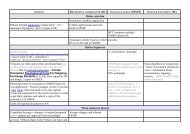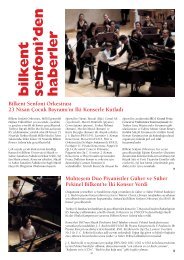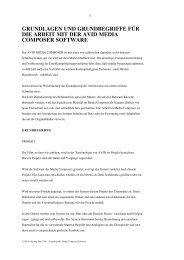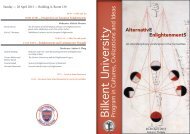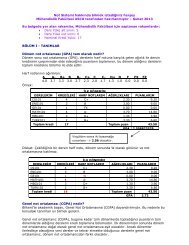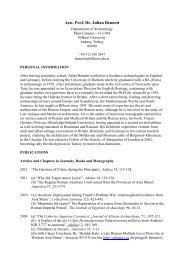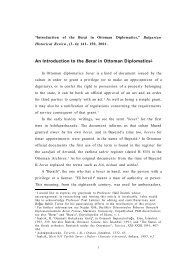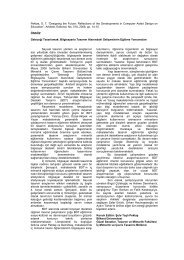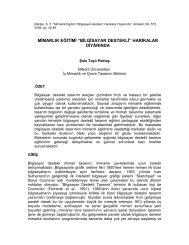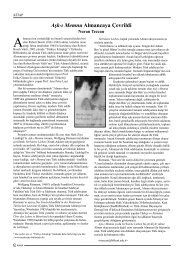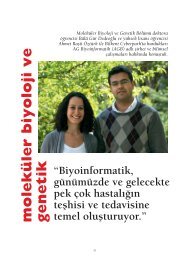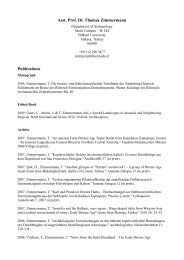German mathematicians in exile in Turkey ... - Bilkent University
German mathematicians in exile in Turkey ... - Bilkent University
German mathematicians in exile in Turkey ... - Bilkent University
Create successful ePaper yourself
Turn your PDF publications into a flip-book with our unique Google optimized e-Paper software.
<strong>German</strong> <strong>mathematicians</strong> <strong>in</strong> <strong>exile</strong> <strong>in</strong> <strong>Turkey</strong> 441<br />
[von Mises, 1939]. Prager too gave a talk dur<strong>in</strong>g the same week and discussed the physical<br />
pr<strong>in</strong>ciples of airplanes [Prager [18], Appendix A]. The 1940–41 <strong>University</strong> Conferences were<br />
devoted, understandably, to the relationship between war and “science” (<strong>in</strong>clud<strong>in</strong>g not just<br />
natural and biological sciences, but also social sciences and humanities). Prager chose the<br />
same topic as before and gave a lecture on scientific problems regard<strong>in</strong>g the construction<br />
of war planes [Prager [20], Appendix A).<br />
4. Publications of von Mises, Prager, and Geir<strong>in</strong>ger at Istanbul <strong>University</strong><br />
Despite their relative isolation and the underdeveloped state of mathematics <strong>in</strong> <strong>Turkey</strong>,<br />
all three emigrés were quite productive dur<strong>in</strong>g their stay. von Mises’ works and publications<br />
throughout his life (<strong>in</strong>clud<strong>in</strong>g those written dur<strong>in</strong>g his Istanbul years) are well-documented<br />
and commented upon by Geir<strong>in</strong>ger who devoted herself to edit<strong>in</strong>g them after von<br />
Mises’ death [Siegmund-Schultze, 2004, 361–366]. Accord<strong>in</strong>g to Geir<strong>in</strong>ger, von Mises produced<br />
30 publications dur<strong>in</strong>g his stay <strong>in</strong> <strong>Turkey</strong>: 17 of them on probability, six of them on<br />
mechanics, and some on practical analysis and geometry. Geir<strong>in</strong>ger emphasized the fact<br />
that dur<strong>in</strong>g this period von Mises’ “<strong>in</strong>terest <strong>in</strong> generals is very great” [Siegmund-Schultze,<br />
2004, 365, emphasis orig<strong>in</strong>al]. This is best reflected by his ma<strong>in</strong> philosophical work,<br />
namely, Positivism published orig<strong>in</strong>ally <strong>in</strong> 1939, a book of 400 pages. Contrary to its title,<br />
this is not a book on positivism, strictly speak<strong>in</strong>g, as von Mises himself notes <strong>in</strong> the preface<br />
[Mises, 1951, v]. Rather, it is a synthetic work of a positivistically m<strong>in</strong>ded scientist, who<br />
reflects on every significant aspect of <strong>in</strong>tellectual life rang<strong>in</strong>g from language to the foundations<br />
of formal, natural and social sciences, from metaphysics and ethics to art, literature,<br />
and religion, emphasiz<strong>in</strong>g the <strong>in</strong>terconnectibility of all human knowledge. One is<br />
tempted to say that it is the k<strong>in</strong>d of book that could only be written <strong>in</strong> relative isolation<br />
and that the <strong>exile</strong> <strong>in</strong> Istanbul seems to have provided the opportunity and the right<br />
circumstances.<br />
Prager too was quite productive dur<strong>in</strong>g his stay <strong>in</strong> <strong>Turkey</strong> between 1933 and 1941. He<br />
published 18 articles (only two of them <strong>in</strong> Turkish, based on his lectures <strong>in</strong> the “<strong>University</strong><br />
Conferences” series) and three books <strong>in</strong> Turkish despite his heavy teach<strong>in</strong>g load. We provide<br />
a list of them as Appendix A. Most of his articles were on plasticity theory, <strong>in</strong>clud<strong>in</strong>g a<br />
jo<strong>in</strong>t paper with Geir<strong>in</strong>ger [Prager and Geir<strong>in</strong>ger [1], Appendix A]. His work <strong>in</strong> Istanbul on<br />
this topic culm<strong>in</strong>ated <strong>in</strong> [Prager, 1942], which he wrote after mov<strong>in</strong>g to the US. In that<br />
paper Prager acknowledges the fact that he started develop<strong>in</strong>g this theory while <strong>in</strong> Istanbul<br />
and presented some of his results <strong>in</strong> the Fifth International Congress of Applied Mathematics<br />
that took place <strong>in</strong> Cambridge, Massachusetts <strong>in</strong> the USA <strong>in</strong> 1938. Indeed, he had already<br />
published two papers on the topic, both of which were written <strong>in</strong> <strong>Turkey</strong> (Prager, [14], [15],<br />
Appendix A). Much earlier, dat<strong>in</strong>g back to a publication <strong>in</strong> 1913, von Mises had contributed<br />
to the theory of plasticity with his own version of the yield theory, nowadays known as<br />
the “Mises’ yield condition”. As it is the case for all such phenomenological theories, its success<br />
depends on how well it approximates the real world, which <strong>in</strong>cludes materials rang<strong>in</strong>g<br />
from soil and concrete to steel, and hence the need for test<strong>in</strong>g the theory for different materials.<br />
Prager argued that the theory did not perform well between the plastic and the elastic<br />
state and developed a new theory that accounts for the transition from the elastic to the<br />
plastic state. The development of his theory dates back to his days at Istanbul <strong>University</strong>,<br />
but is not conf<strong>in</strong>ed to those times. In fact, a recent survey <strong>in</strong> strength theories <strong>in</strong>dicates the



